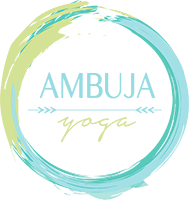
Hey there fellow yogis! As a yoga teacher, mama, wife, and retreat leader, my heart is always yearning for ways to deepen my own practice and flourish in my many roles. I’ve always been an avid reader and podcast listener… well, until the tiny human arrived, that is. Now that Atlas is “marginally” more independent, one of my intentions for this year is to reclaim the bits and pieces of myself that I tucked away while nurturing this tiny human and welcome the new parts of me that have come to the forefront while on this motherhood journey. This is my time to reclaim my love of reading, so I’ve gathered and researched to fill my home yoga library with loads of inspiring books on yoga, motherhood, and personal transformation. My desire is to come back to a place that feels a little more harmonious rather than chaotic. Yes, I know the chaos will keep on rolling, but maybe it can feel a little more easeful? I’m hopeful!
I always love sharing what’s currently inspiring me, so I thought I would share what I’m reading this year. We’re definitely a “book house”, but I’ve been reading a lot of picture books over the past couple of years. I am more than ready to read some books that are “just for me”. And while I love reading with Atlas and plan to continue satiating his 15+ books a day habit, I’m so thankful it’s still early in 2024 because there are a lot of books I’m looking forward to reading this year.
I am beyond excited to dive into some incredible books that will enrich both my personal journey and my offerings to you all. Let’s take a peek at the gems that I am currently reading and what I’m eagerly anticipating. I hope you’ll also find some inspiration here among these great books.
Inspiring Books on Motherhood, Personal Transformation, and Yoga for 2024
Motherhood
Beautiful Chaos by Jessica Urlichs: Jessica writes the most beautiful poetry that captures all of the emotions of motherhood. Her words are so relatable. Many tears have been shed while reading her poetry. Beautiful Chaos is her newest book and the paperback isn’t released yet, so I caved and bought the Kindle version.
Good Inside by Dr. Becky Kennedy: If you’re a parent who strives to be gentle and firm, to be respectful, and provide clear boundaries this one is for you. It’s so insightful and encouraging. Her message is clear: we are all good inside. You’ll likely feel inspired to clear up any childhood or generational trauma of your own.
Yoga
Yoga for Transformation: Ancient Teachings and Practices for Healing the Body, Mind, and Heart by Gary Kraftsow: I’ve been teaching yoga at a power yoga studio, and I feel like my practice has drifted toward the physical. I’m feeling called to get back to the other seven limbs of yoga. I regularly reference Gary Kraftsow’s Yoga for Wellness book, so this felt like the right addition to my yoga library.
The Path of the Yoga Sutras by Nicolai Bachman: I’ve been teaching from this book for years, and it’s time for me to revisit it. This is one of the most accessible yoga sutra books I’ve come across.
Personal Transformation
The Luminous Self by Tracee Stanley: I’m simultaneously reading The Luminous Self and loving it. I love being a mother; however, after having Atlas, I really felt like I lost myself in motherhood. Tracee shares practices that guide you into the depths of your being and help you remember the radiant essence within. I’m loving this book. I look forward to sharing some of these practices in upcoming offerings.
If Women Rose Rooted by Sharon Blackie: This book had been circling in my periphery for months (maybe years), and it’s finally landed in my hands. I’m reading it currently and I wish I had picked it up sooner. “If Women Rose Rooted” speaks to the parts of me that feel most at home and most rooted when my feet are planted on the earth. It’s a beautiful book that inspires living in alignment with the cycles of life and nature. I’ve already learned so much! I appreciate Sharon Blackie’s exploration of native mythology, feminine wisdom, and empowerment, while still being gentle, empowering, and encouraging. This is great on Audible and they often have free trials.
The Pivot Year: 365 Days to Become the Person You Truly Want to Be by Brianna Wiest: Ah, the sweet promise of transformation! I’ve been intrigued by Brianna Wiest’s work. When I was choosing my books for the year, I felt like I could start with basically any of her books. It was hard to choose where to start. “The Pivot Year” came last week in the mail and it beckons with daily invitations to self-discovery, growth, and possibility. I appreciate the simplicity of this book as it provides a short one or two-paragraph inspirational reading for each day. The part of me that wants to be “all-in” all the time wants to dive into this book right now. However, I know I need time to integrate the teachings and wisdom from The Luminous Self – so I’ll probably start this one in another month or two.
Rewilding by Micah Mortali: “Rewilding” speaks to me on a primal level. In its own way, it offers a roadmap back to our roots. I look forward to exploring Micah’s blend of yoga, mindfulness, and nature connection to rediscover the wild spirit within. What is rewilding? “Rewilding is a return to our essential nature. It is an attempt to reclaim something of what we were before we used words like ‘civilized’ to define ourselves.” ― Micah Mortali. My soul craves being out in nature with my feet in running water and my hands on the earth!
The Enchanted Life: Unlocking the Magic of the Everyday by Sharon Blackie: Toni brought this book to the Back to Nature Retreat last year. I was able to read the first quarter of it during our downtime and I look forward to finishing it. “The Enchanted Life” speaks of childlike wonder and possibility. It is a beautiful reminder to see the world through eyes alight with curiosity and awe.
Embody Your Inner Goddess by Lauren Leduc: Lauren’s book was recommended by a fellow yogini as we chatted after class about our spiritual journey, seasons of life, motherhood, etc. I took a peek inside and Lauren does an amazing job of honoring the feminine spirit. She offers beautiful practices to nurture, empower, and transform us in a really gentle and accessible way.
The Four Agreements by Don Miguel Ruiz: Simple yet profound, “The Four Agreements” is full of timeless wisdom. Don Miguel Ruiz’s principles serve as gentle reminders to live authentically and walk the path of integrity. This is a great book to revisit again and again. If you like Audible, it’s a short inspiring listen that is great for the car, train, etc.
Each of these books holds the promise of growth, insight, and inspiration. Each book was mindfully chosen for its potential to guide us deeper into the heart of our practice and the essence of who we are. As I eagerly turn the pages, I invite you to join me on this sacred journey of exploration and discovery. What’s inspiring you? What inspiring books are you reading?
Disclosure: Some of the links above are affiliate links. This means that, at zero cost to you, I will earn a small affiliate commission if you click through the link and finalize a purchase. The small commissions I earn from the Amazon Affiliate program help cover my basic web hosting fees. I am so grateful for your support.

 Ambuja Yoga
Ambuja Yoga 















